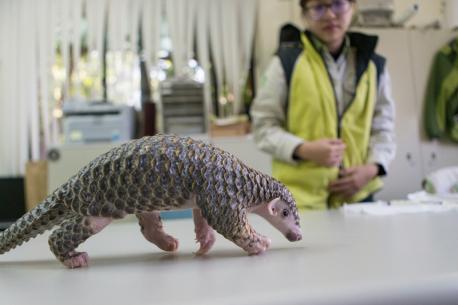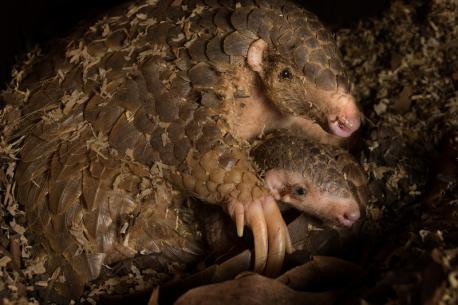Results: Pangolins: the most trafficked mammals (Part 1 of 2)
Published on 03/07/2017
(Sources: worldwildlife.org and CNN) Pangolins are solitary, nocturnal animals. They are easily recognized by their full armor of scales. A startled pangolin will cover its head with its front legs, exposing its scales to any potential predator. If touched or grabbed it will roll up completely into a ball, while the sharp scales on the tail can be used to lash out. They are called scaly anteaters because of their preferred diet.
There's something wonderful about encountering a creature you had no idea existed, and that millions of years of evolution helped create. The earliest pangolin fossils date back to the Eocene epoch, 35 million to 55 million years ago, shortly after the dinosaurs went extinct. It once was thought that pangolins were most closely related to anteaters, sloths and armadillos. New evidence, however, suggests they may be more similar to carnivorans, a diverse group of animals that includes cats, civets, dogs and pandas. The name pangolin comes from a Malay word meaning "one that rolls up." Can you mention any other animal, aside the anteater – and some dogs and cats - that rolls up completely to sleep?

QUESTIONS
GO to COMMENTS
Comments
1.
1.
A CNN journalist, John D. Sutter, defined a pangolin as a rare, scale-covered mammal, about the size of a house cat, that's so bizarre it almost forces your brain to flip through a Rolodex of more-familiar images. It could be described as a walking pinecone or an artichoke with legs – a tiny dinosaur or friendly crocodile. The pangolin possesses none of the cachet of better-known animals that are hot on the international black market. It lacks the tiger's grace, the rhino's brute strength. If the pangolin went to high school, it would be the drama geek -- elusive, nocturnal, rarely appreciated and barely understood. When it's frightened, it curls up into a roly-poly ball. Did you ever see a pangolin?

Yes
8%
161 votes
No
92%
1849 votes
2.
2.
The pangolin could go extinct before most people realize it exists. Or, more to the point: it could go extinct because of that. Pangolins are increasingly victims of illegal wildlife crime—mainly in Asia and in growing amounts in Africa—for their meat and scales. Eight species of pangolins are found on two continents. Four species live in Africa and four in Asia. All eight pangolin species are protected under national and international laws, and two are listed as Critically Endangered on the IUCN Red List of Threatened Species. No one knows how many pangolins are left in the wild. But scientists and activists say the number is shrinking fast. Some experts say the pangolin is likely the most trafficked mammal in the world. But aside from pangolins, only elephants would come close to the most-trafficked title in terms of total numbers. Did you know these stats before this survey?

Yes
8%
151 votes
No
92%
1859 votes
3.
3.
The San Diego Zoo is the only one in North America that has a pangolin. His name is Baba. The zoo used to have two pangolins, but one died of digestive problems. It's known that pangolins can live up to 20 years in captivity, for example, but it's not clear exactly how long they live in the wild. Pangolins eat ants, termites and various larvae, but it's also possible they consume bee larvae, flies, worms and crickets, according to a 2007 technical review of pangolin diets and husbandry. Estimates on their weight range from 4 to 72 pounds. Did you visit the San Diego Zoo?

Yes
15%
300 votes
No
85%
1710 votes
COMMENTS


